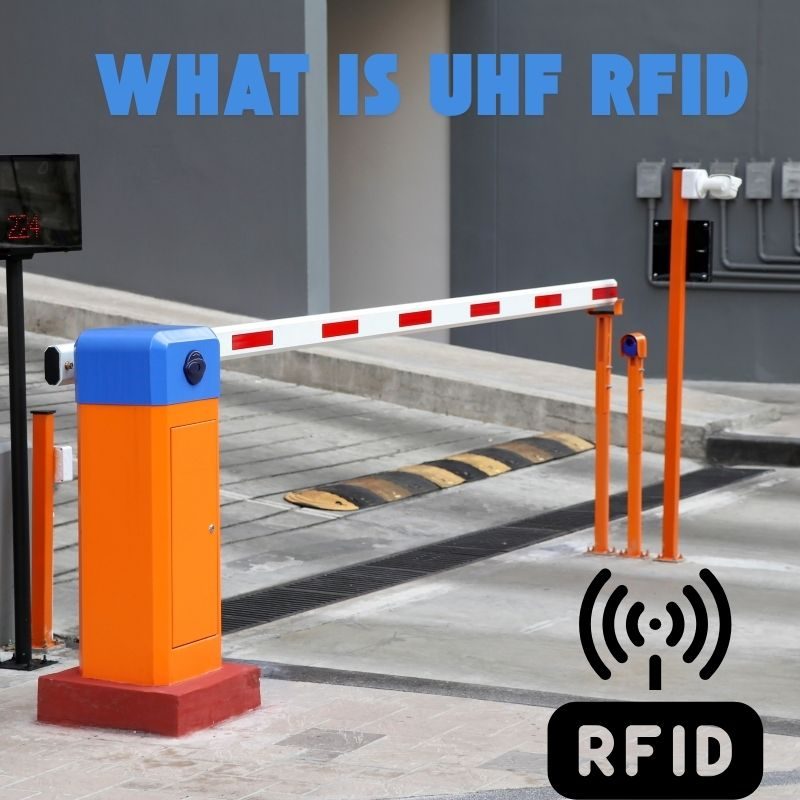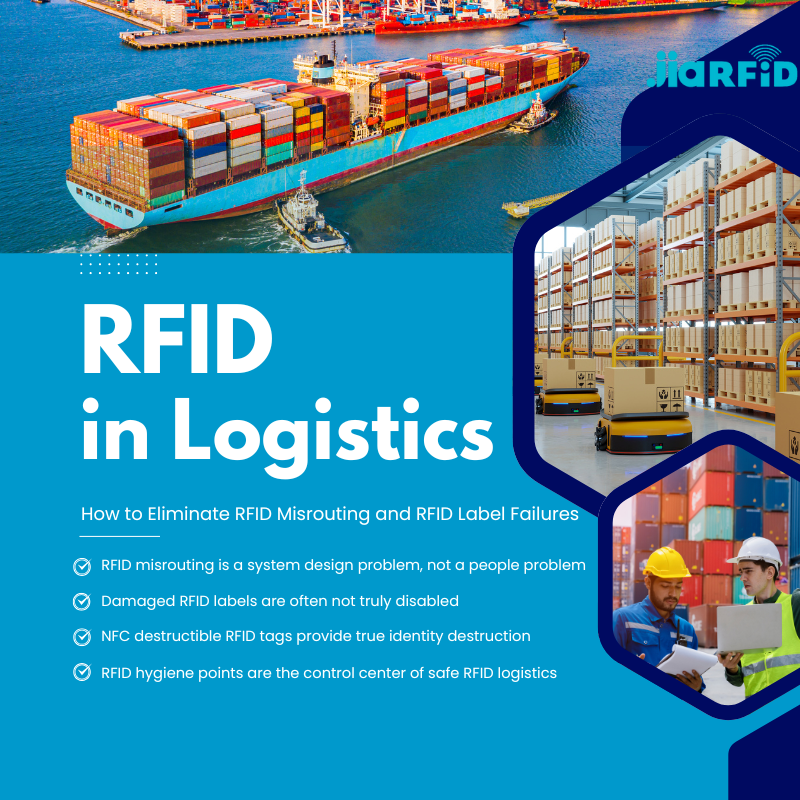
What is UHF RFID?
Table of Contents
Introduction
UHF RFID (Ultra-High Frequency Radio Frequency Identification) is a cutting-edge identification technology gaining momentum across various industries. From retail and logistics to healthcare and agriculture, its ability to enable fast, contactless data exchange is transforming how businesses operate.
Whether you’re exploring RFID for the first time or looking to deepen your understanding, this guide will walk you through what UHF RFID is, how it works, its applications, and why it’s a must-know technology in 2025.

What is UHF RFID?
UHF RFID, short for Ultra-High Frequency Radio Frequency Identification, is a wireless communication technology that uses radio waves to identify and track tags attached to objects. It’s one of the three major frequency categories in RFID technology — the other two being Low Frequency (LF) and High Frequency (HF).
UHF typically operates within the 860 MHz to 960 MHz range and is well known for:
- Longer read ranges (up to 12 meters or more)
- Faster data transmission
- Bulk reading capability
In simpler terms, UHF RFID is like a digital “barcode on steroids” — no line of sight needed, and hundreds of items can be read instantly.
How Does UHF RFID Work?
To understand how UHF RFID functions, let’s look at its core components:
- RFID Tags: Contain a microchip and antenna that store data.
- RFID Readers: Emit radio waves and receive data from tags.
- Antennas: Boost the signal between tags and readers.
- Middleware/Software: Processes and manages the data collected.
There are two main types of UHF RFID tags:
- Passive UHF Tags: Rely on energy from the reader’s signal; cheaper and commonly used.
- Active UHF Tags: Battery-powered; suitable for long-range and real-time applications.
Key Functionality:
- The reader emits a signal in the UHF band.
- The tag receives energy, powers on, and sends its data back.
- The reader collects this data and sends it to a backend system for processing.
The system can read multiple tags simultaneously, even at high speeds — making UHF RFID ideal for dynamic environments like conveyor belts or fast-moving inventory.
Benefits of UHF RFID Technology
Why is UHF RFID gaining so much traction? Because it solves real-world tracking and automation challenges. Here are the standout benefits:
- Long Read Range: Up to 12 meters, even in rugged environments
- Bulk Reading: Read hundreds of tags in seconds
- Cost-Efficient: Passive tags are affordable for large-scale use
- Real-Time Visibility: Instant updates on inventory and asset movement
- Non-Line-of-Sight: No need to scan directly like with barcodes
- Scalability: Suitable for small operations or global supply chains
In short, it boosts efficiency, accuracy, and automation — key pillars for modern businesses.
Common Applications of UHF RFID
UHF RFID has emerged as a core technology in modern automation and tracking systems, offering exceptional range, speed, and versatility. Its ability to read hundreds of tags simultaneously and at long distances makes it invaluable across a wide range of industries.
Retail
- Inventory control
- Anti-theft systems
- Automated checkout
- Real-time stock updates
Logistics & Supply Chain
- Shipment tracking
- Pallet management
- Cross-docking operations
- Proof of delivery
Manufacturing
- Work-in-progress (WIP) tracking
- Quality control
- Equipment monitoring
Healthcare
- Patient wristbands
- Equipment tracking
- Pharmaceutical inventory
Agriculture
- Livestock monitoring
- Farm equipment tracking
- Smart irrigation systems
Libraries & Education
- Book tracking
- Lab asset management
- Access control
No matter the industry, UHF RFID offers real-time visibility, efficiency, and traceability.
UHF RFID vs HF and LF RFID – Key Differences
| Feature | LF (Low Frequency) | HF (High Frequency) | UHF (Ultra-High Frequency) |
|---|---|---|---|
| Frequency | 125–134 kHz | 13.56 MHz | 860–960 MHz |
| Read Range | ~10 cm | ~1 m | Up to 12 m |
| Data Speed | Slow | Moderate | Fast |
| Cost | Low | Moderate | Varies |
| Use Cases | Animal tracking | Contactless payments | Supply chain, retail, logistics |
UHF RFID offers the longest read range and fastest performance, making it ideal for fast-paced environments and high-volume tracking.
UHF RFID Standards and Regulations
Standards govern global use of UHF RFID to ensure compatibility:
- EPCglobal Gen2 / ISO 18000-6C: Industry standard for passive UHF RFID
- FCC (USA): Operates in 902–928 MHz
- ETSI (Europe): Operates in 865–868 MHz
- Other Regions: Vary slightly depending on telecom regulations
It’s crucial to ensure compliance with regional frequency regulations when deploying UHF RFID globally.
Types of UHF RFID Tags
Passive UHF RFID Tags
- Most common
- Cost-effective
- Used in retail, logistics, etc.
Active UHF RFID Tags
- Battery-powered
- Longer range
- Used in high-value asset tracking
Semi-Passive (BAP) Tags
- Battery-assisted for better performance
Tag Form Factors
- Inlays
- Labels
- Hard tags
- Ruggedized tags for metal or harsh environments
Choose the tag type based on your environment, range requirements, and budget.
Challenges and Limitations of UHF RFID
Like any tech, UHF RFID isn’t perfect. Here’s what to consider:
- Metal and Liquid Interference: Can block or distort signals
- Environmental Factors: Extreme temperatures can affect performance
- Line-of-Sight Limitations: Tags in dense stacks may not be read reliably
- Upfront Cost: Infrastructure setup can be expensive
- Data Overload: Requires robust software to handle large-scale data collection
But with careful planning, these limitations can be minimized or mitigated entirely.

Future Trends in UHF RFID (2025 and Beyond)
UHF RFID isn’t just here to stay — it’s evolving fast. Trends include:
- Integration with IoT: Smart sensors + RFID = powerful data insights
- Cloud-Based RFID Systems: Manage tags from anywhere
- AI & Machine Learning: Predictive analytics using RFID data
- Smart Cities & Infrastructure: Traffic flow, waste management, and more
- Industry 4.0: Real-time factory automation and digital twins
With lower costs and better performance, expect mass adoption across industries by the end of the decade.
Is UHF RFID Right for You?
UHF RFID is a powerful, scalable technology that can help your business reduce manual processes, cut losses, and improve visibility. Whether you’re managing a warehouse or tracking high-value medical devices, the benefits of long-range, high-speed data capture are game-changers.
But, like all tech, success lies in understanding its strengths and deploying it correctly.
Ready to explore UHF RFID for your business? Start by consulting with a trusted RFID solution provider or conducting a pilot program to evaluate your needs.
FAQs About UHF RFID Technology
What does UHF RFID stand for?
UHF RFID stands for Ultra-High Frequency Radio Frequency Identification. It refers to RFID systems that operate in the 860–960 MHz frequency range and are capable of reading tags from several meters away.
How does UHF RFID work?
UHF RFID systems use radio waves to communicate between a reader and a tag. The reader sends out a signal that powers up passive tags, which then send their data back to the reader. This enables quick, wireless identification of objects without needing a direct line of sight.
What is the range of a UHF RFID system?
UHF RFID systems typically have a read range of 3 to 12 meters (10 to 40 feet) for passive tags. Active tags with batteries can extend the range significantly, sometimes up to 100 meters or more.

Ray Zhou
This article was written by Ray Zhou, an RFID technology expert with more than 10 years of industry experience.
Comments
Hot Products

RFID in Logistics: How to Eliminate RFID Misrouting and RFID Label Failures
RFID in logistics is more than just a tool to speed up processes. It has become a key part of how modern supply chains operate.

What Is RFID Waste Management
Imagine a city where every trash bin speaks — not literally — but through a tiny chip that tells the system when it’s full, when it’s emptied, and where it went. That’s what RFID waste management is doing today.

What are Bolt Seals and their Applications? | Complete Guide
In global trade and logistics, bolt seals play a crucial role in ensuring cargo security and compliance. These small but powerful devices are designed to lock shipping containers, trailers, and cargo doors with a tamper-evident mechanism.

What is an RFID Card Protector? Benefits, Use Cases, and Buying Guide
RFID technology (Radio Frequency Identification) is everywhere: in your credit cards, ID badges, transit passes, hotel room keys, and more. It offers speed and convenience, but it also opens the door to a new kind of digital theft called “skimming.” That’s where an RFID card protector comes in.

RFID Wristbands for Events: Bulk Buying Guide for Organizers
RFID wristbands for events are becoming the go-to solution for organizers who need faster entry, fraud prevention, and cashless payments at concerts, festivals, and sports venues. Unlike paper tickets or QR codes, these smart wristbands use embedded chips to streamline access, secure transactions, and improve the guest experience.

How RFID Tag on Windscreen Improves Vehicle Access Control and Toll Systems
In today’s fast-paced world, vehicle identification needs to be quick, secure, and contactless. An RFID Tag on the Windscreen provides exactly that — a reliable way to manage toll collection, parking, and gated access without stopping vehicles.
Tags
RELATED BLOGS

RFID in Logistics: How to Eliminate RFID Misrouting and RFID Label Failures
RFID in logistics is more than just a tool to speed up processes. It has become a key part of how modern supply chains operate.

What Is RFID Waste Management
Imagine a city where every trash bin speaks — not literally — but through a tiny chip that tells the system when it’s full, when it’s emptied, and where it went. That’s what RFID waste management is doing today.

What are Bolt Seals and their Applications? | Complete Guide
In global trade and logistics, bolt seals play a crucial role in ensuring cargo security and compliance. These small but powerful devices are designed to lock shipping containers, trailers, and cargo doors with a tamper-evident mechanism.




